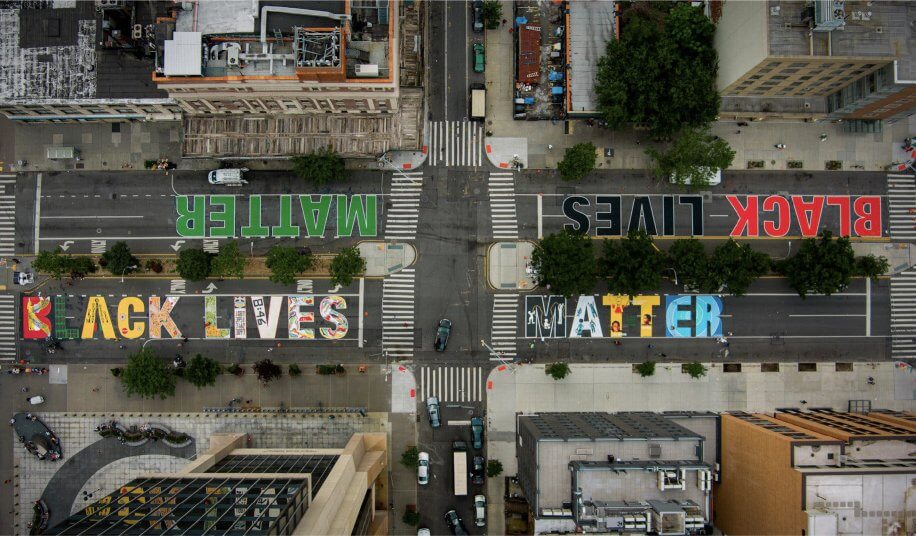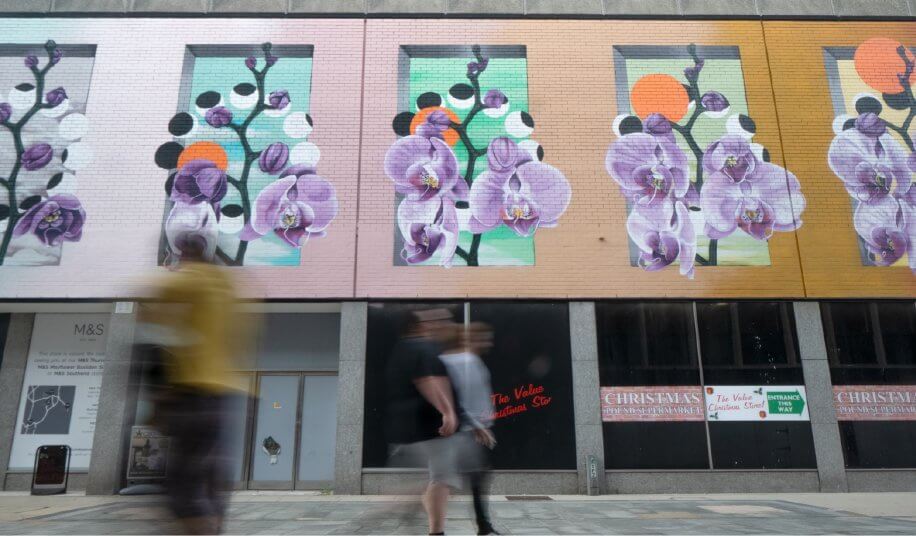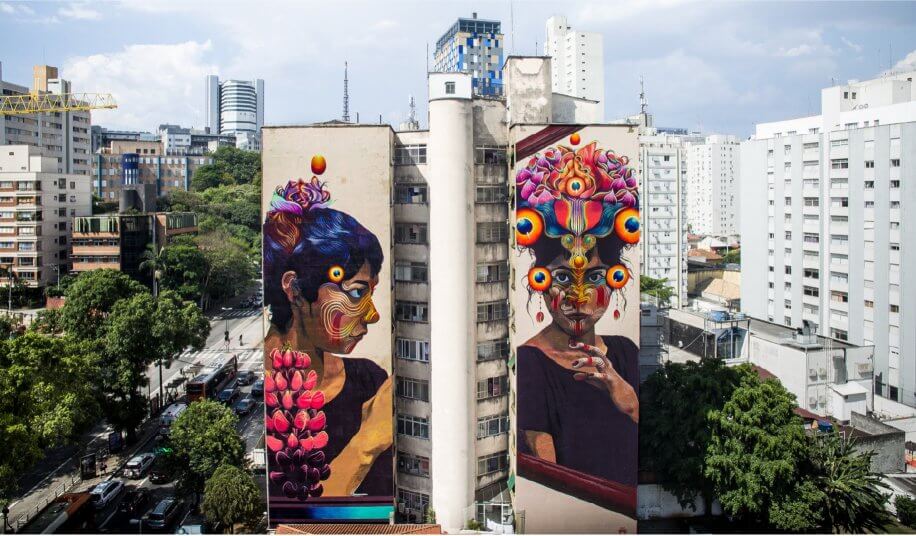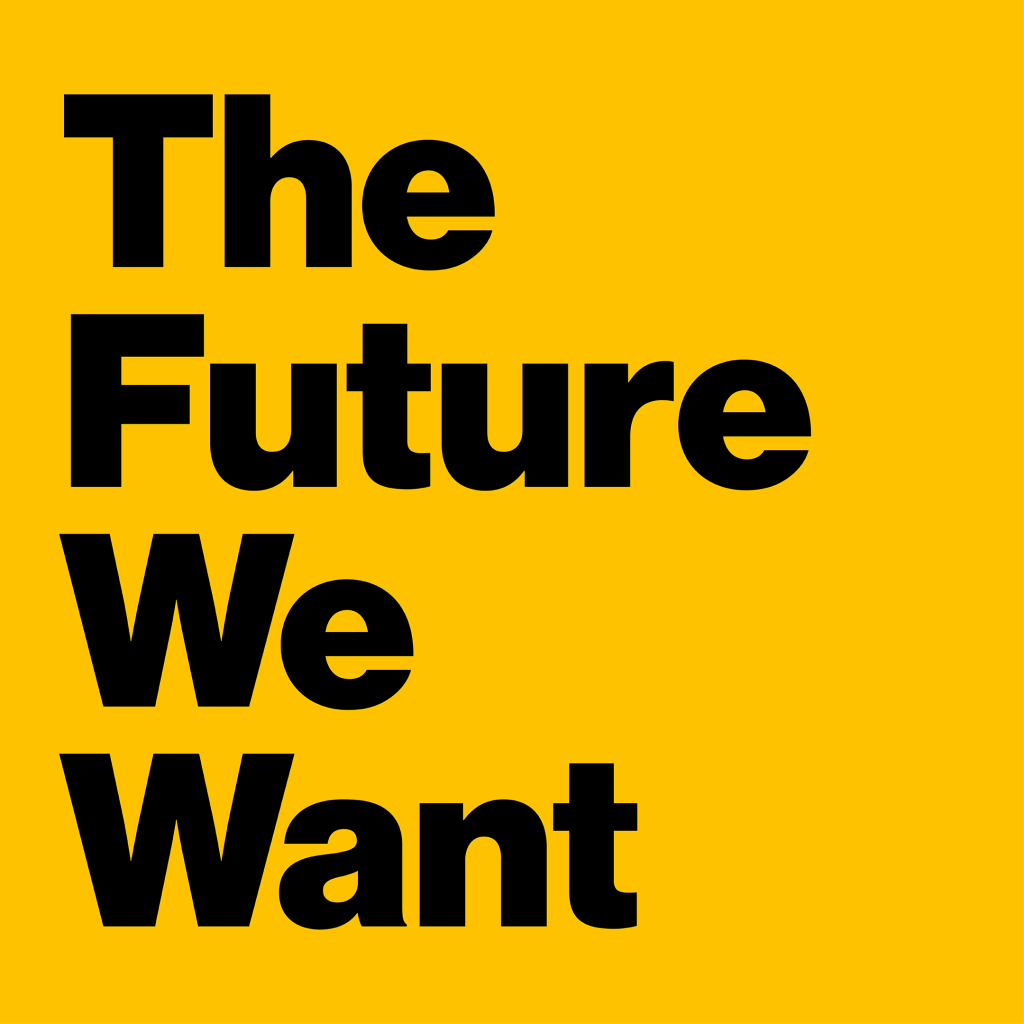Shifting Dialogues Through Public Art

Over the past two weeks, two crucial conversations have been taking place in Glasgow.
One was in the confines of the COP26 conference where invited guests from heads of state, influential members of the media, revered climate scientists, and thought leaders discussed how to tackle the urgent threats of climate change.
The other conversation took place outside in the streets where climate activists, indigenous community leaders, and concerned citizens from all walks of life showed up to demand action above and beyond what our governments and institutional leaders are committing to. The street-level conversation – which included everything from protests to performances to art installations – aimed to turn up the pressure on world leaders and raise the public’s awareness of what’s at stake and what worthwhile solutions could look like.
Among the messages happening in the public space outside COP26 was a call to action from Fifth Wall, a venture capital firm whose Climate Tech Fund is focused on decarbonizing the real estate industry. Their mural series #ChooseEarth has appeared alongside recent global climate events to draw attention to the need for meaningful investments in climate technologies to decarbonize the built environment.
When Fifth Wall approached BBMG to create this campaign, we were excited to use public art as an inspiring medium to engage with their audience and community. Unlike traditional advertising or digital campaigns, a series of location-specific murals in New York, Los Angeles, and at COP26 allowed us to work differently and leverage the unique qualities of public art.
Using this format also challenged us to shift the narrative from communicating the shocking facts (like the real estate industry is responsible for 39% of emissions – yes really!) to lead with a timely concept that challenges the billionaire space race to focus on our home planet. The medium invited us to distill the message and create an emotional image with the power to stop people in their tracks.
From the political murals of Diego Rivera to the AIDS Memorial Quilt to the Guerilla Girls, creating public art to enact social change is not a new concept. It’s very much a part of our shared human experience and is as relevant as ever as a powerful way to raise public awareness, promote action for positive change and revitalize spaces.
There are many benefits to using murals to get your message out there:
Public art can bring communities together
The very nature of creating a mural is a collaborative process. From the concept to the rigorous planning and painting, it’s an opportunity for meaningful discussions and a chance to get local communities involved. For #ChooseEarth, we partnered with local artists in NYC (Steffi Lynn) for Climate Week, in Los Angeles (Kent Yoshimura) for the Milken Institute’s Global Conference, and in Glasgow (artist Bobby “RogueOne” McNarmara) and The Portrayals, an organization “painting Scotland’s Climate Story,” to bring our COP26 mural to life. Each artist created a mural based on their interpretation of the concept, allowing each wall to be unique to the community it’s in and become a magnet for local conversation related to climate events – and beyond.
As we thought about the role of public art to create beauty and unity in a community, we took inspiration from two murals honoring Black Lives Matter in Harlem, the epicenter of African American culture in NYC. One mural brought together eight artists, each having creative control of two letters. At the same time, over 300 members from local community groups painted the other mural. The bright colors and bold, 21-foot-tall typography became a place of healing and brought hope for residents during some of the most difficult times of 2020.

Public art also has the potential to take on a life of its own. A mural painted by street artist Akse P19 of soccer player Marcus Rashford in Manchester, UK brought a community together by turning hate into hope. The artwork, created to honor his commitment to reducing child hunger, was vandalized with racist abuse hours after Rashford and his teammates missed penalties in the Euro 2020 final. But by the following day, messages of support and love transformed the wall into a space of solidarity for residents and visitors.
Public art invites audience participation
While public art is a refreshing break from the digital world we inhabit, by using hashtags, QR codes, and Insta-worthy visuals, we can create opportunities to physically place yourself within an image and bring public art into the social media space as well. For the #ChooseEarth series, we looked at the ways other murals invite passers-by to engage with the art and designed our pieces with human interaction in mind; a space for a person to physically place themselves in the art or an illustration that deliberately reaches out and makes you the focal point.
We’re also intrigued by the unexpected ways that murals can connect with audiences using new technologies like augmented reality. A commissioned mural by British artist INSA that’s part of a series in the UK city center of Basildon is explicitly painted frame by frame so audiences can view it in motion. Inspired by the near-threatened green-winged orchid found in the area, the flower grows when used with an AR app created by the artist. Similarly, animation studio BUCK painted a wall in NYC’s Industry City, ‘Ricci‘, which uses a scanned QR code to transform the mural into a 3D experience. Artists Eric Skotnes and Ryan Sarfati also recently launched the largest augmented reality mural, ‘The Majestic’ in Tulsa, OK.
Creating this physical attraction for people to visit invites the audience to spend more time with the image, sparking discussions and connections.

Public art can increase accessibility
You don’t need a ticket to enjoy public art. You don’t need an invitation. Murals are free of social, physical, and sometimes language barriers. They exist in cities regardless of economic development and are either at ground level or viewed from ground level, often eliminating accessibility issues many institutions still have.
Sao Paulo is an example of a city transformed for the better by public art. When the 2006 Clean City Law (Lei Cidade Limpa) banned extensive outdoor advertising and graffiti was decriminalized in 2009, it created more room for large-scale art. Today the city is famous for its murals, and it recently launched the Street Art Museum 360. Here, a global audience can view its digital gallery of 40 murals.
Renowned graffiti artist Banksy is known for bringing the equality of public art beyond the streets. In 2019 he opened his online shop Gross Domestic Product to ensure affordable editions of his artwork were available. To weed out the people acquiring art to turn a profit, you need to prove you are not a robot by answering “Does art matter?” before making a purchase.

Public art shows us that important conversations about the future of our planet like COP26 can’t be limited to legislators, world leaders, and invited guests. Murals invite us to join – and inform – the other crucial conversations happening in the streets. Public art has the power to break through in a way other communication vehicles cannot, meeting people where they are, bringing communities together, and ultimately shifting perspectives. And today, the choices we make can be inspired by it.


